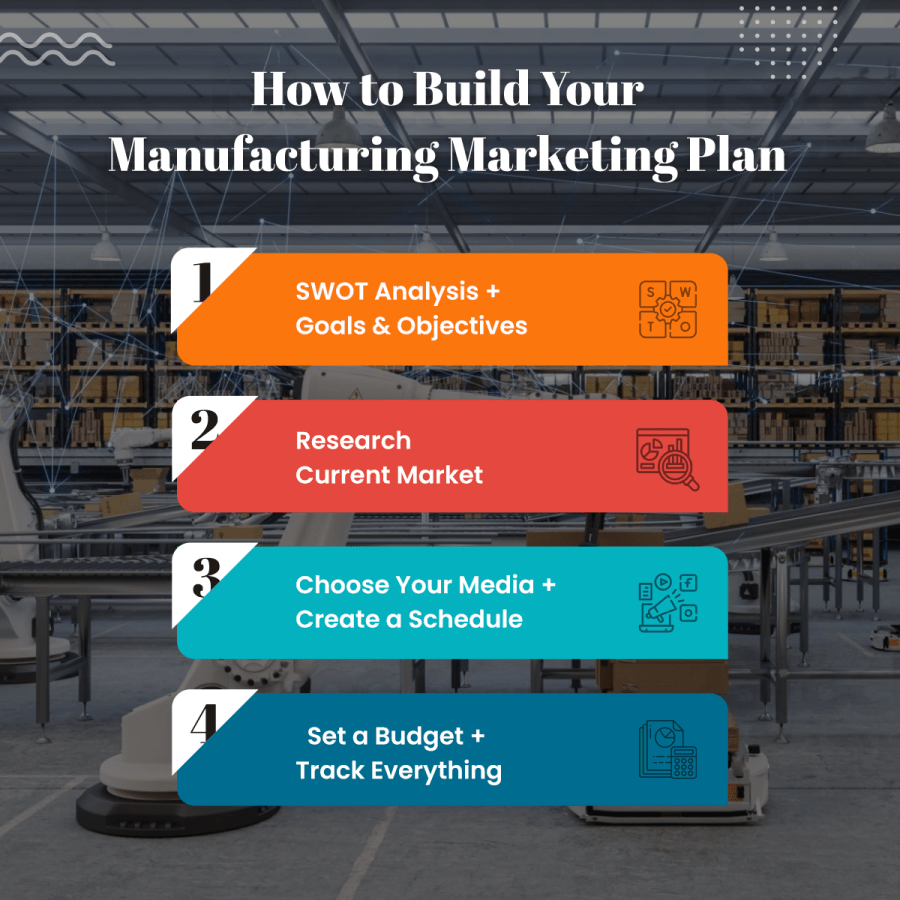
Most manufacturers don’t review their marketing data at all because they’re not even collecting it. This blind spot is killing their growth potential in today’s digital-first world. Everything your customers do online is trackable and traceable, yet most manufacturing companies are flying blind, missing crucial insights that could transform their business.
As a digital marketing agency that works exclusively with manufacturing companies, we’ve seen firsthand how data can revolutionize a manufacturer’s approach to finding and winning business. The days of relying solely on word-of-mouth and trade shows are behind us, but many haven’t caught up to this reality.
How Digital Marketing for Manufacturers Has Shifted the Sales Dynamic
Thanks to the internet and the ability to research anonymously, the buying power has shifted dramatically from sales reps to customers. Sales representatives used to control the conversation, sharing features and benefits on their terms. That’s not how it works anymore.
Millennials, who are increasingly moving into decision-making positions, are twice as likely to be skeptical of sales rep claims than baby boomers. Bottom line, people are doing their own research, and this trend accelerated during the pandemic.
What many manufacturing leaders don’t realize is that more than 70% of the buyer’s journey is completed before talking to anyone at any company. When B2B buyers are considering a purchase, they spend only 17% of that time meeting with potential suppliers. When comparing several companies, the time spent with any one sales rep may be only 5-6% of their total purchasing process.
Since 95% of the journey happens without you, you have very little opportunity to influence customer decisions directly. This is why understanding what happens in your prospect’s mind as they search for solutions is absolutely critical.
Random Acts of Marketing vs. Strategic Data Collection
Most manufacturers we encounter practice what we call “random acts of marketing” – disconnected efforts with no coherent strategy or measurement system. They might have a website they haven’t updated in years, a LinkedIn page they rarely post to, and perhaps attend a few trade shows annually. There’s nothing wrong with these activities, but when they’re not connected to data collection and analysis, they’re just expensive shots in the dark.
The biggest challenge we see is manufacturers not tracking data and not attributing sales to their marketing efforts because they don’t have a system in place. Many think that simply asking a customer “how did you find us?” provides all the information they need. This couldn’t be further from the truth.
There are countless interactions that happen before a prospect calls or fills out a form – often before they even realize they need your product or service. With proper tracking, you can identify which blog article brought in which prospects, which ads generated engagement, and how visitors navigate through your website. It’s all trackable and traceable.
The Real-World Impact of Data-Driven Marketing for Manufacturers
Let me share a success story. We work with an HVAC manufacturing and installation company – a second-generation business where the father had a 30-year run with all word-of-mouth sales. But over the past decade, sales began to wane. When his sons took over, they recognized the need to leverage technology and data.
We helped them create new messaging and positioning content, building a website as the hub of their marketing efforts. Then we wrote and posted articles that answered the exact questions facility managers ask about HVAC systems. The content strategy had Google Search Optimization in mind, alongside targeted pay-per-click advertising.
The key turning point was when we researched and analyzed the specific keywords and phrases their ideal customers were typing into search engines when looking for solutions. This wasn’t guesswork – it was data-driven certainty. By understanding the challenges, their ideal customer profile faced and the exact language they used, we could create content that would be found by ideal prospects.
The results? Sales increased dramatically, including landing a half-million-dollar deal that came directly through their digital marketing efforts. The data told us exactly what was working and allowed us to double down on those strategies.
Understanding the Buyer’s Journey Through Data
When manufacturers start collecting and analyzing their marketing data properly, they discover that customers do, in fact, move through a marketing funnel quite systematically:
- Awareness Stage: Where the buyer becomes aware they have a problem.
- Consideration Stage: Where they define their problem and consider options to solve it.
- Decision Stage: Where they evaluate and decide on the right provider.
Without data, you’re guessing where your prospects are in this journey. With data, you can meet them exactly where they are with the right content and messaging at each stage.
A buyer’s journey describes their path to purchase. They go through this process to become aware of, consider, evaluate, and finally decide to purchase a new product or service. By understanding the pain points, they experience along that journey and the factors that shape their thinking, we can better position your product or service along that path.
The DTD Way: A Data-Driven Approach for Manufacturers
At David Taylor Digital, we’ve developed what we call “The DTD Way” – a cyclical marketing approach emphasizing continuous improvement based on real-time data and insights.
It’s built around four key phases:
Strategize: Define goals and objectives, identify target audiences and key messages, and develop a comprehensive way forward based on data, not assumptions.
Execute: Implement the plan according to the defined strategy, utilizing various digital marketing channels and tactics like website design and development, content creation, SEO, SEM, and digital advertising.
Learn: Monitor and collect data from the execution phase, analyzing performance metrics to understand what’s working and what needs improvement, identifying patterns and trends.
Report: Share transparent reports on performance with stakeholders, discussing insights, key metrics, results, and unexpected findings – then loop back to strategize with these new insights.
This approach recognizes that a website is never “done” – it’s a constant work in progress. The same applies to all marketing efforts. You can’t hit it out of the park immediately, but as research and data flow in, you can make adjustments and improvements. Analyzing the data trends month over month gives you the ability to refine and fine-tune your efforts. If you get just a little better every day, you’ll see exponential results over time.
Creating a Single Source of Truth
One of the biggest challenges manufacturers face is siloed data across departments. Sales has their CRM data, marketing has website analytics, operations has customer service information – but nobody has the complete picture.
We address this by funneling all tools into one reporting dashboard for our clients, tracking and measuring all marketing activity in one place. We believe in transparency in all things, and sharing this data with everyone involved keeps all stakeholders in the loop. This creates a single source of truth that aligns sales and marketing efforts.
When everyone can see how marketing activities translate to leads and sales, it transforms the conversation from “marketing costs money” to “marketing generates revenue.” This shift in perspective is crucial for manufacturers, who traditionally view marketing as an expense rather than an investment.
The Key Metrics Manufacturers Should Track
For manufacturers just starting to build their marketing data foundation, here are the specific metrics we’ve found most valuable:
- Keyword rankings: What terms are bringing people to your site?
- Lead sources: Which channels are generating inquiries?
- Organic website traffic: How many people are finding you naturally?
- Total leads: How many potential customers are in your pipeline?
- Ad impressions, clicks, and click-through rates: How are your paid efforts performing?
- Engagement metrics: How are visitors interacting with your content?
- Website health and speed: Is your site providing a good user experience?
- Top-performing website pages: What content resonates most with your audience?
These metrics provide actionable insights that can directly inform your marketing strategy without overwhelming your team with data overload.
A Phased Approach to Marketing Data
For manufacturers who find all of this overwhelming, we recommend taking a phased approach:
Phase 1: The Foundation Phase
Start by establishing your online presence:
- Update and optimize your website
- Set up Google My Business
- Create branded social media accounts
- Establish relevant keywords people search on Google
- Benchmark key metrics and review them monthly
Phase 2: The Traffic Phase
Once your foundation is solid, focus on driving traffic:
- Implement email marketing
- Start a Google SEO campaign by blogging about prospect problems and solutions
- Make on-page SEO edits to attract Google
- Launch Google Advertising (PPC) and implement comprehensive search engine marketing solutions.
- Set up email sequences to nurture prospects
Phase 3: The Reputation Phase
With traffic flowing, build your authority:
- Roll out paid social media advertising
- Implement reputation management (collect and respond to reviews)
- Build website authority with link building strategies
- Create branded downloadable content like white papers
- Start tracking website visitors using tools like HubSpot
This phased approach allows you to grow your marketing efforts while still having time to focus on your core business operations.
The Path Forward for Manufacturers
The manufacturing sector is at a crossroads. As baby boomers retire and millennials take decision-making positions, digital-first buying has become the norm. The pandemic only accelerated this trend, increasing everyone’s comfort with digital research, learning, and buying.
Most manufacturing owners I speak with tell me they get all their business from word-of-mouth leads and referrals from networking. But if you think that’s the only way to get business in this industry, you may have your head in the sand. People are searching for products and services online in ALL industries – even manufacturing. And the younger they are, the more they search online to find their own solutions.
The power has shifted, and manufacturers who embrace data-driven marketing will have a tremendous advantage over those who don’t. The good news is that it doesn’t require a complete overnight transformation. By taking a phased approach and focusing on collecting the right data before making big decisions, you can gradually build a marketing system that delivers predictable, measurable results.
The manufacturers who will thrive in the coming decades aren’t necessarily those with the best products – they’re the ones who can get their products in front of the right people at the right time with the right message. And that’s exactly what data-driven marketing enables.
Remember, your marketing data isn’t just for reporting – it’s a strategic asset that can transform your business. It’s time to stop guessing and start knowing.
Transform Your Manufacturing Marketing Strategy Today
Stop relying on guesswork. As your dedicated digital marketing partner, we’ll help you implement a data-driven approach that delivers measurable results for your manufacturing business. Our team understands the unique challenges of your sector and can guide you through each phase of marketing evolution.





